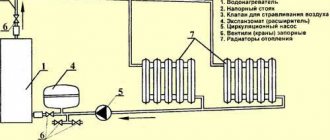Defrosting the heating system is one of the few problems that private home owners are actually afraid to face. In essence, defrosting is a process when the coolant in heating pipes or appliances simply freezes. Such a situation can become a real disaster - after all, if this happens, the house is left without heating for a long time - and the system requires major repairs. What to do to avoid getting into such a situation? And how to defrost the heating system?
Defrosting a heating pipe
About preventing freezing
A very important aspect is the choice of pipes for the heating system of the building. The weakest point of all pipes is corrosion processes. The most durable material is cast iron; according to manufacturers of cast iron batteries, they can last up to 100 years. The least resistant is aluminum, whose service life is about 10 years. Steel batteries will last you 25 years. Plastic pipes are not subject to corrosion, scale is not deposited in them, and they will last 50 years.
In addition, such pipes will not burst if the heating system needs to be defrosted - only a slight swelling will be visible in that place.
The owner of the house must be personally present at the moment when the heating system of a private house is launched. First of all, you need to pay attention to the welded joints, as well as how the pipes are laid in the trenches. Before filling them, you need to make sure that the thermal insulation of the pipes is in the gravel “backfill”.
Otherwise, deformation or even rupture may occur. It is also necessary to check how reliably the threaded connections of heating systems are sealed in areas where welding is not required.
How to prevent
First of all, it is worthwhile to take a competent approach to planning and installing the heating system. In particular, the possibility of using an auxiliary power source should be provided - this is especially true in regions where power outages occur quite often. This way, you can prevent system downtime - and, accordingly, freezing of the coolant.
When installing a heating system, you should pay quite a lot of attention to the type of materials you use.
In particular, aluminum pipes should not be used as system elements - they have a relatively short service life - a maximum of 10 years. Steel and copper pipes are more reliable - they can easily serve you for 20 years without requiring replacement. However, cast iron radiators and pipes are considered to be the true “long-livers”. If installed, they may need to be repaired (or replaced) after 50 years. However, it should be understood that metal pipes are in most cases susceptible to corrosion. In addition, if low-quality water is used, plaque forms on the inner walls of the pipes, which significantly reduces their thermal conductivity and shortens their service life.
In this case, it is more rational to use plastic pipes. They are not subject to corrosion and no sediment forms on them. Such components have a long service life - at least 35 years.
Another significant advantage of plastic pipes is that if the heating system defrosts, the pipe does not “break”, as happens with metal. Even if such an unpleasant situation occurs, the plastic pipe will only swell a little.
Of course, an important means of protecting pipes of any type from such an incident as freezing of heating pipes is high-quality thermal insulation. This is the application of a special material to the pipe, which prevents the coolant circulating in it from freezing. In order to protect the pipes as much as possible from extreme cooling, you should be especially careful when laying pipes underground. In particular, it must be taken into account that the pipe should under no circumstances come into contact with the ground. It should lie on a cushion of crushed stone and be covered with thermal insulation. Particular attention should be paid to pipe joints - such places are most susceptible to the heating system freezing.
Equipment for quick defrosting of the heating system
With the help of one of these devices, you will have the most modern and fastest defrosting method - within a few minutes, ice plugs in the pipes will be removed. With the use of such devices, an electric current is passed through the defrosted pipes at low voltage; the current strength should be equal to 400 Amperes.
The power depends on the length of the pipe - it can be adjusted from 1.7 to 4 kW.
If defrosting is necessary in pipes of large diameters, then they resort to using several devices simultaneously. The duration of this process is half an hour. The main thing is that the sealing of threaded connections of heating systems is not broken during defrosting.
Prevention measures
It is better to prevent any trouble in advance. As for measures to counter freezing of pipes, they can be divided into two groups: installing the system again and correcting the existing situation.
In order to properly remount the system you need to:
- Choose pipes with a diameter of at least 40 mm.
- It is advisable to use plastic pipes, since metal ones tear more easily under the influence of ice.
- Do not lay pipes near brick walls and foundations, and use a double layer of insulation in places where they pass through the fence.
- The pipes must be laid below the freezing level of the soil.
- All external pipes must be insulated.
In order to correct the existing situation, there is only one option: installing a heating cable. Moreover, it is the internal heating cable, since in order to lay the cable on the pipe, you will have to open the layer of earth above the communications, and in this case you can install the system again.
As you can see, there is nothing difficult about defrosting pipes yourself. The main thing is to do everything quickly and in compliance with all safety measures.
Anti-icing and network heating systems
There is one more unfavorable nuance: pipes burst, which subsequently washes away the house structure with water, and the foundation is eroded. Next, you will need to carry out serious repairs, which will entail impressive amounts of costs. To avoid such an unpleasant moment, you can use a system of anti-icing and network heating of pipes.
To ensure continuous external defrosting of the heating system, a heating device such as a resistive series cable is used.
This system is good to use for pipes of considerable length. If compact heating is required, a self-regulating cable can be used.
To ensure anti-icing in drinking water pipes, a cable of this type is laid directly inside the pipes.
Climate
0 votes
+
Vote for!
—
Vote against!
Winter is a time of year that not only brings unforgettable and joyful experiences from New Year's Eve or skiing. Winter is a severe test, both for living beings and for all kinds of engineering systems that are created by man to improve his life. Low temperature tests apply directly to the water supply. In cold weather, it happens that water pipes freeze. Therefore, knowledge of how to defrost pipes in winter and not be left without water during this time will be quite useful.
- Hot water
The need to defrost pipes
If you have not insulated your water pipes in a timely manner, a situation may occur when the water in the pipes freezes. If you paid attention in time to the occurrence of force majeure with tap water, then this is not a reason to panic at all. There are many ways, including “folk” ones, how to defrost a water pipe with your own hands.
For trivial reasons, water pipes freeze: incorrect pipe laying technology (for a given area, the freezing depth is not taken into account or the pipes are not insulated), as well as the lack of heating in the room. Also, the reasons for freezing of the system may be as follows: very small volumes of water are transported through the pipes, or the pipes are operated at very low temperatures.
It should be taken into account that defrosting pipes that are laid in accessible places does not cause any particular difficulties (for example, they just need to be warmed up using an ordinary household hair dryer), but some difficulties may arise with defrosting pipes when laid underground. It’s quite good if the pipes are frozen at the entry point, since you can simply heat up the walls. But often the freezing point is a few meters from the building.
The issue of defrosting pipes is solved with the help of improvised means that are available in every home: a blowtorch, an electric heater, a professional hair dryer (you can also use a hair dryer). But before you consider options for defrosting water pipes, you need to understand a few useful tips.
The defrosting process is quite simple if the pipes are metal. For this purpose, we take a regular welding machine and connect it to different ends of the pipe. This simple method eliminates this problem within 3 to 4 hours. The longer the frozen section of the pipe, the longer it takes to defrost. But today, mainly PE pipes are used in water supply networks, which are made of high-density polyethylene and can withstand pressures of up to 10 atmospheres.
They do not collapse when frozen and are not subject to corrosion processes. Due to its properties, polyethylene does not act as a conductor of electric current, and this means that it is impossible to carry out defrosting using a welding machine. Removing ice plugs with a steel rod is also fraught with danger and can damage the pipe.
Traditional methods of defrosting pipes
Today there are a lot of defrosting methods, so the process of removing ice from sewer or water pipes is not very difficult.
External heating
External defrosting of pipes has a very important drawback - it is necessary to open the trench in which the sewerage system is laid. Digging the frozen soil itself (and this is what it is if ice has formed in the pipe), it is clear that this is not the most pleasant task. But still, if the size of the cork is not particularly large, then this method may be worth using.
After you have opened the trench, you need to look at the material from which the pipe is made. There is a difference in how to defrost polyethylene or metal pipes. In the first case, you need to use electric heaters so that the temperature is not very high - up to 100-110 degrees. With all this, it also makes sense to cover the additionally excavated area with a decent layer of thermal insulation during the heating process, so the back side of the device will not heat the street, and the pipes will warm up faster.
For metal pipes, we apply the method of using open fire using equipment such as gas burners, blowtorches, firewood, as well as any flame sources with a long burning time. From such influences, the plastic may simply melt.
Internal heating
Defrosting sewer pipes, compared to water pipes, has certain nuances. On the one hand, the large diameter of such pipes provides significant advantages for internal heating. On the other hand, these pipes provide a fairly large volume of accumulated ice with frozen soil, and therefore a large contact area, which will lead to increased heat transfer from both external and internal heaters.
Before you defrost plastic pipes from the inside, you need to make a not very complicated device: attach a U-shaped heating element to a board with rounded edges. At the same time, it is required that the bend protrudes beyond the front edge of the board; other parts of the heating element should not protrude beyond it, so that there is no contact with the walls of the heater pipe.
Since its dimensions and distance to the plug are known, to defrost plastic pipes it is also necessary to attach a wire of the appropriate length to the contacts of the heating element, and attach a small piece of metal-plastic pipe to the board itself, which will serve as a pusher.
The entire structure is pushed in from the side of the wastewater receivers, because the slope of the sewerage system is made in this particular direction; there is simply nowhere for the melted water to flow from above. In this case, the heating element is turned on in the network only after it is placed inside the pipe, and with each movement as the plugs melt, it is accordingly turned off.
Metal pipe machine
The most effective means of removing ice from water pipes is an industrial pipe defrost machine. But such a device is intended only for metal pipes; this technique does not apply to plastic pipes. The operating principle of the device is quite simple and understandable. Terminals are attached to the edges of the required section of the pipe that needs to be defrosted, and then current is supplied. After this, the pipe heats up and begins to thaw the frozen area.
When using an apparatus for defrosting metal pipes, the following data should be analyzed: a pipe up to 23 meters long and with a diameter of up to 6 centimeters defrosts in up to 60 minutes. With a larger pipe diameter, it is necessary to install terminals at a shorter length, especially in the area of various tie-ins and measuring instruments. When defrosting water or sewer pipes, there must be water pressure in the system.
Unconventional methods of defrosting pipes
In addition to traditional methods of heating pipes, we can offer you three defrosting methods for polyethylene pipes, which are the “know-how” of our craftsmen. Regardless of some eccentricity, they still work. Their only drawback is that they are only suitable for pipelines that have a small diameter.
Hot water
When using this method, it is necessary to take into account that the ice plug will not allow hot water to get inside if you just pour it in. This means it is necessary to find a way to supply hot water to the frozen zone. You can defrost a pipe by using a pipe or hose with a smaller diameter. For example, if it is necessary to defrost a water pipe with a diameter of 25 or 30 millimeters, and the frozen section is straight, then the use of metal-plastic pipes with a diameter of 16 millimeters will be more effective.
To begin with, we straighten the metal-plastic pipe, and then push it into the frozen pipe until it touches the ice. After this, we supply hot water through the pipe to the freezing point. Thawed water will pour out through the gap between the metal-plastic pipe and the water pipe. If your water supply is limited, then you can use the thawed water in a second circle, that is, heat it up and again direct it to the place of freezing.
At the same time, the ice plug will melt, and it will be possible to continue manual defrosting of the pipe and push the small metal-plastic pipe further. But if the section of the pipe that is frozen has turns and bends, it will not be possible to use a rigid metal-plastic pipe in this case. But you can take a hard hose.
It should be noted that an ordinary watering hose is not suitable for this; it will simply soften from hot water and will be impossible to push through. In such a situation, hoses for connecting a gas cylinder and oxygen hoses turned out to be effective. These hoses are quite rigid, but you can still push them no more than 15 meters from the input. In addition, such hoses are quite heavy and must be pushed through the pipe with great effort.
Esmarch's irrigator
Now it’s worth figuring out how to defrost a pipe if ice has accumulated tens of meters from your home, and the pipeline itself has turns and bends. Still, there is an economical and effective way: for such purposes you will need a set of a construction hydraulic level, an Esmarch mug (banal enema) and hardened steel wire. This set is inexpensive, and households have many of its components.
First you need to align the wire and the hydraulic level tube, and then screw the end of the wire to the hydraulic level with electrical tape. In order to provide greater hardness at the end of the wire, it is necessary to make a loop. The wire itself should not stick out, and the end of the hydraulic level tube should protrude one centimeter in front of the wire. The other end of the hydraulic level must then be connected to Esmarch’s mug, and then the wire and tube must be pushed into the water supply until it stops.
Due to the fact that the hydraulic level tube has a small diameter and light weight, it moves quite easily through the pipeline, while overcoming all turns quite easily. After this, add hot water, giving an “enema” to the frozen water supply. It is necessary to place a container under the water pipe to collect the thawed water, because as much hot water is poured in, the same amount of cold water will be poured out.
Then we push the wire with the hydraulic level tube gradually as the ice melts. This method of defrosting pipes is very time-consuming, that is, you can only defrost up to one meter of pipeline in an hour. This means that during working hours you can defrost 5-7 meters of pipe from ice.
Current Usage
Consider the following situation, when you have a frozen polyethylene water pipe 50 meters long, 20 millimeters in diameter, and the laying depth is up to 80 centimeters. It should be noted that this depth for laying a water supply system is insufficient, which is why the water supply system froze. Another distinctive feature is that the water supply is located under the roadway. In this case, utility workers usually advise waiting until the thaw sets in, but there is still a way when you can do without it.
You will need the following equipment: a plug for the socket, a two-core copper wire (we select the thickness and length of the cross-section according to the diameter and length of the frozen water supply), a hose and a compressor for pumping out thawed water. Let's say, for a pipe with a diameter of 20 millimeters, you can take a wire of 2.5-3 millimeters and a car fuel hose with a diameter of 8 millimeters, as well as a regular car compressor (you can, in extreme cases, use a pump).
We warn you that when using this method of self-defrosting pipes, you need to be extremely careful, because the work is performed using high voltage. Now we need to prepare all this for thawing of the pipes. It is necessary to remove the outer insulation from a small section of the wire, divide it into two wires, remove the insulation from one of them, and carefully bend the remaining wire in the insulation in the opposite direction along the water supply. In this case, care must be taken to ensure that the insulation is not damaged.
Next, almost near the bend of the wire, you should make 3-5 turns of bare wire (as close to each other as possible) and cut off its remaining end. After this, you need to retreat 2-3 millimeters from the made turns, then expose the second wire and wrap it around the wire in the same way. The turns of the first and second wires should not touch.
And to the other end of the wire we connect the “unit” and the plug (such a device is popularly called a “bulbulator”). If you place it in water and connect it to the electrical network, then when current passes through the water, a corresponding reaction occurs, in which a large release of heat occurs. Such a device is ideal in this case, because only the water is heated, and the wires themselves remain cold, that is, the plastic pipes are not even accidentally scorched.
This assembled device must be checked. For this purpose, it is recommended to place the device in a jar of water and connect it to the power supply. If a slight hum is felt and bubbles leave the contacts, then the unit is working. We remind you once again: while the device is working, contact with water may cause an electric shock.
We continue to defrost the pipe ourselves. The wire must be pushed carefully into the pipe so that it does not bend. Therefore, it is necessary to take a wire of a larger cross-section. When the wire hits the ice plug, you need to turn on the “bulbulator” and wait one or two minutes. After this, you need to try to push the wire further, because the ice has begun to melt.
When about a meter of pipe is thawed, the melted water must be blown out using a compressor; this is necessary to reduce the volume of heated water and to prevent the water supply from freezing again in already thawed areas. If you have special equipment, it is advisable to weld a tap onto the pipe. When water flows through the pipe, do not pull out the wire from it, but close the tap, this way the place where the defrosting procedure is being carried out will not flood.
How to prevent pipes from freezing
You have already figured out how to deal with ice in water pipes. But you can prevent this if you try. To prevent plastic pipes from freezing, you must remember:
- Pipes should be laid at a depth that exceeds the freezing level of the soil in your region. It is advisable to lay sewer and water pipes at a depth of at least 120-140 centimeters.
- There is no need to lay sewer and water pipes next to reinforced concrete structures (beams, supports, grillages, foundations) due to the fact that the thermal conductivity of concrete is much greater than the thermal conductivity of the soil, that is, the risk of soil freezing from reinforced concrete structures increases. In this case, it is necessary to insulate the pipes (for example, place slabs of special extruded polystyrene foam between the reinforced concrete structures and the pipeline).
- If finances allow, then a heating cable should be laid next to the pipeline. The production of heating self-regulating cables, which are switched on only when necessary, has already been mastered.
- It is advisable to insulate places where pipelines pass through the walls of structures and buildings with mineral wool, foam and glass wool to avoid direct contact of the walls of the building with the walls of the pipe.
- When installing a water supply system at your dacha, it is best to use pipes that have a diameter of at least 50 millimeters, because pipes with a smaller diameter are more susceptible to freezing.
- When choosing between a variety of polymer water pipes, you need to know that polypropylene pipes can burst after 2-3 defrosts, while polyethylene pipes withstand repeated defrosting and freezing processes very well.
- If in winter the sewerage system and water supply are used irregularly, then the best option would be to completely drain the water from the system.
Thus, in winter, owners of private houses often encounter water in their water supply freezing. In this situation, the main thing is to react in time and take the necessary measures. To defrost a water pipe, you can use traditional defrosting methods using a special pipe defrosting machine and using internal and external heating. Also, along with this, there are effective alternative methods, tested by folk craftsmen in practice.
Methods for defrosting pipes
Each stage of defrosting pipes must comply with rules that must be followed. For example, how to check the tightness of the heating system during defrosting. If you decide to defrost yourself, you need to adhere to the following:
- Before defrosting, fully open the tap, which is located directly near the place where the water freezes in the pipes.
- Defrosting should be done slowly, gradually moving from the unscrewed tap to distant areas of the frozen pipe.
- The temperature does not need to be very high, it should be approximately such that a person can touch the pipe with his hand.
- When a pipe overheats, steam is formed; if the pressure created in the pipe is excessive, it can rupture, similar in nature to an explosion.
The simplest defrosting option is to turn on the autonomous heating system. When the house begins to warm up, the pipes themselves will go through the defrosting stage.
A fairly effective way to defrost in wooden floors or walls is to install electric lamps with a reflector that reflects heat energy. Electrical wiring is designed for power exceeding that used for an electric lamp.
Each of the listed defrosting methods is allowed to be used for metal-plastic pipes.
The temperature of such pipes during defrosting should not exceed 120 degrees.
More on this topic on our website:
- Collector heating system for a two-story house Heating affects comfortable and cozy living in the house. Therefore, the choice of heating your home must be approached with all seriousness. If your home has...
- The Leningrad heating system, the scheme of which is widely used in multi-storey and private buildings, is one of the most common schemes for organizing heating in buildings. Heating by…
- Gas heating is characterized by its low cost of energy, but is inferior to electric heating in terms of accessibility to the general population, ease of installation and ease of operation. Therefore, for many citizens of our country, electric...
- A country house can be a building equipped with various communications and high-quality furniture, but all luxury will become meaningless if the housing is not heated or the heating system is not...
How to prevent
First of all, it is worthwhile to take a competent approach to planning and installing the heating system. In particular, the possibility of using an auxiliary power source should be provided - this is especially true in regions where power outages occur quite often. This way, you can prevent system downtime - and, accordingly, freezing of the coolant.
Diagram of parallel connection of radiators, it is easiest to defrost
When installing a heating system, you should pay quite a lot of attention to the type of materials you use.
In particular, aluminum pipes should not be used as system elements - they have a relatively short service life - a maximum of 10 years. Steel and copper pipes are more reliable - they can easily serve you for 20 years without requiring replacement. However, cast iron radiators and pipes are considered to be the true “long-livers”. If installed, they may need to be repaired (or replaced) after 50 years. However, it should be understood that metal pipes are in most cases susceptible to corrosion. In addition, if low-quality water is used, plaque forms on the inner walls of the pipes, which significantly reduces their thermal conductivity and shortens their service life.
In this case, it is more rational to use plastic pipes. They are not subject to corrosion and no sediment forms on them. Such components have a long service life - at least 35 years.
Another significant advantage of plastic pipes is that if the heating system defrosts, the pipe does not “break”, as happens with metal. Even if such an unpleasant situation occurs, the plastic pipe will only swell a little.
Plastic heating pipes
Of course, an important means of protecting pipes of any type from such an incident as freezing of heating pipes is high-quality thermal insulation. This is the application of a special material to the pipe, which prevents the coolant circulating in it from freezing. In order to protect the pipes as much as possible from extreme cooling, you should be especially careful when laying pipes underground. In particular, it must be taken into account that the pipe should under no circumstances come into contact with the ground. It should lie on a cushion of crushed stone and be covered with thermal insulation. Particular attention should be paid to pipe joints - such places are most susceptible to the heating system freezing.
Why does the heating freeze in a private house?
Owners of private houses often face a situation where the heating freezes in winter. There may be several reasons for this:
- A sharp drop in air temperature, uncharacteristic for the region.
- Stagnation of water in the system due to the prolonged absence of the owners of the house.
- Insufficient pipe insulation.
- Ventilation holes not closed for the winter. During the cold season, cold air penetrates through them and freezes the system.
- The temperature of the operating heating system is not high enough.
- Dilapidation of pipes and thermal insulation material.
- Untimely draining of water from the system.
Sometimes the cause of freezing in a private house is weak draft in the chimney. This happens if coniferous trees are used for the firebox.
Why was it “unfrozen” and not “frozen”?
Then it let go :-))). Not fatal (Frost frost) - he didn’t die ))))))))))
It is no longer possible to eradicate this











